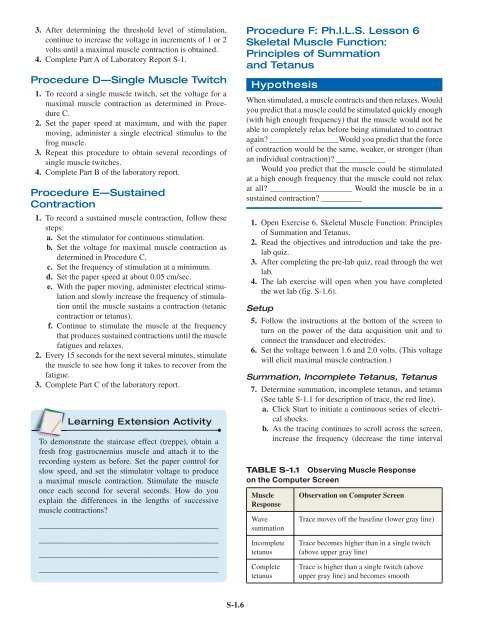S-1 Skeletal Muscle Contraction - McGraw-Hill Higher Education
S-1 Skeletal Muscle Contraction - McGraw-Hill Higher Education
S-1 Skeletal Muscle Contraction - McGraw-Hill Higher Education
Create successful ePaper yourself
Turn your PDF publications into a flip-book with our unique Google optimized e-Paper software.
3. After determining the threshold level of stimulation,<br />
continue to increase the voltage in increments of 1 or 2<br />
volts until a maximal muscle contraction is obtained.<br />
4. Complete Part A of Laboratory Report S-1.<br />
Procedure D—Single <strong>Muscle</strong> Twitch<br />
1. To record a single muscle twitch, set the voltage for a<br />
maximal muscle contraction as determined in Procedure<br />
C.<br />
2. Set the paper speed at maximum, and with the paper<br />
moving, administer a single electrical stimulus to the<br />
frog muscle.<br />
3. Repeat this procedure to obtain several recordings of<br />
single muscle twitches.<br />
4. Complete Part B of the laboratory report.<br />
Procedure E—Sustained<br />
<strong>Contraction</strong><br />
1. To record a sustained muscle contraction, follow these<br />
steps:<br />
a. Set the stimulator for continuous stimulation.<br />
b. Set the voltage for maximal muscle contraction as<br />
determined in Procedure C.<br />
c. Set the frequency of stimulation at a minimum.<br />
d. Set the paper speed at about 0.05 cm/sec.<br />
e. With the paper moving, administer electrical stimulation<br />
and slowly increase the frequency of stimulation<br />
until the muscle sustains a contraction (tetanic<br />
contraction or tetanus).<br />
f. Continue to stimulate the muscle at the frequency<br />
that produces sustained contractions until the muscle<br />
fatigues and relaxes.<br />
2. Every 15 seconds for the next several minutes, stimulate<br />
the muscle to see how long it takes to recover from the<br />
fatigue.<br />
3. Complete Part C of the laboratory report.<br />
Learning Extension Activity<br />
To demonstrate the staircase effect (treppe), obtain a<br />
fresh frog gastrocnemius muscle and attach it to the<br />
recording system as before. Set the paper control for<br />
slow speed, and set the stimulator voltage to produce<br />
a maximal muscle contraction. Stimulate the muscle<br />
once each second for several seconds. How do you<br />
explain the differences in the lengths of successive<br />
muscle contractions?<br />
____________________________________________<br />
____________________________________________<br />
____________________________________________<br />
____________________________________________<br />
Procedure F: Ph.I.L.S. Lesson 6<br />
<strong>Skeletal</strong> <strong>Muscle</strong> Function:<br />
Principles of Summation<br />
and Tetanus<br />
Hypothesis<br />
When stimulated, a muscle contracts and then relaxes. Would<br />
you predict that a muscle could be stimulated quickly enough<br />
(with high enough frequency) that the muscle would not be<br />
able to completely relax before being stimulated to contract<br />
again? _________________Would you predict that the force<br />
of contraction would be the same, weaker, or stronger (than<br />
an individual contraction)? ____________<br />
Would you predict that the muscle could be stimulated<br />
at a high enough frequency that the muscle could not relax<br />
at all? ____________________ Would the muscle be in a<br />
sustained contraction? __________<br />
1. Open Exercise 6, <strong>Skeletal</strong> <strong>Muscle</strong> Function: Principles<br />
of Summation and Tetanus.<br />
2. Read the objectives and introduction and take the prelab<br />
quiz.<br />
3. After completing the pre-lab quiz, read through the wet<br />
lab.<br />
4. The lab exercise will open when you have completed<br />
the wet lab (fig. S-1.6).<br />
Setup<br />
5. Follow the instructions at the bottom of the screen to<br />
turn on the power of the data acquisition unit and to<br />
connect the transducer and electrodes.<br />
6. Set the voltage between 1.6 and 2.0 volts. (This voltage<br />
will elicit maximal muscle contraction.)<br />
Summation, Incomplete Tetanus, Tetanus<br />
7. Determine summation, incomplete tetanus, and tetanus<br />
(See table S-1.1 for description of trace, the red line).<br />
a. Click Start to initiate a continuous series of electrical<br />
shocks.<br />
b. As the tracing continues to scroll across the screen,<br />
increase the frequency (decrease the time interval<br />
TABLE S-1.1 Observing <strong>Muscle</strong> Response<br />
on the Computer Screen<br />
<strong>Muscle</strong><br />
Response<br />
Wave<br />
summation<br />
Incomplete<br />
tetanus<br />
Complete<br />
tetanus<br />
Observation on Computer Screen<br />
Trace moves off the baseline (lower gray line)<br />
Trace becomes higher than in a single twitch<br />
(above upper gray line)<br />
Trace is higher than a single twitch (above<br />
upper gray line) and becomes smooth<br />
S-1.6
















